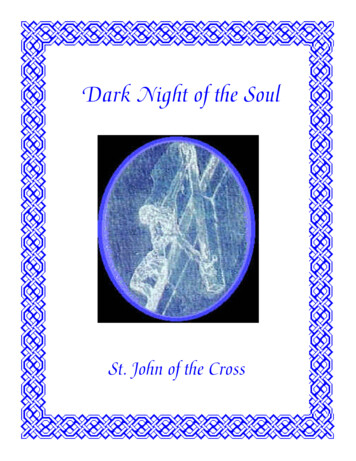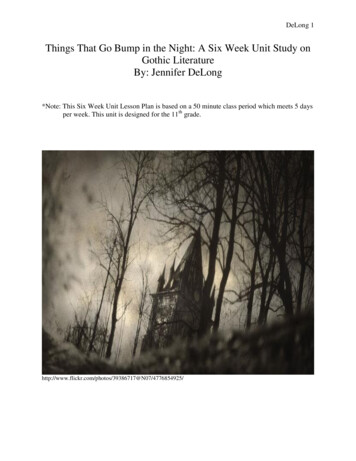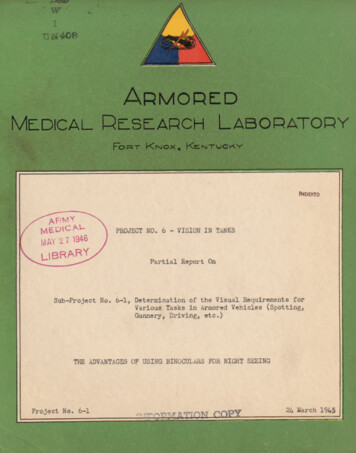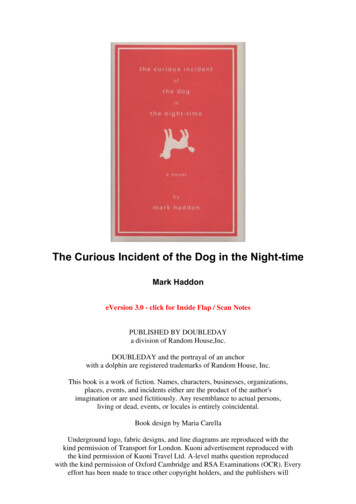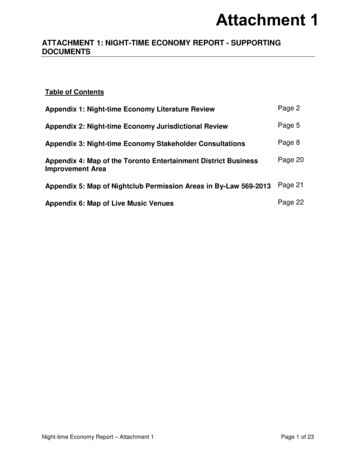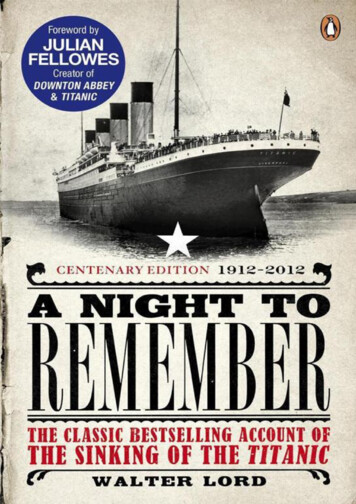
Transcription
WALTER LORDA Night to RememberWith a Foreword by Julian Fellowes and an Introduction by Brian LaveryPENGUIN BOOKS
ContentsForeword by Julian FellowesIntroduction by Brian LaveryPreface1 ‘Another Belfast Trip’2 ‘There’s Talk of an Iceberg, Ma’am’3 ‘God Himself Could Not Sink This Ship’4 ‘You Go and I’ll Stay a While’5 ‘I Believe She’s Gone, Hardy’6 ‘That’s the Way of It at This Kind of Time’7 ‘There is Your Beautiful Nightdress Gone’8 ‘It Reminds Me of a Bloomin’ Picnic’9 ‘We’re Going North Like Hell’10 ‘Go Away – We Have Just Seen Our HusbandsFacts about the TitanicPassenger ListIllustrationsAcknowledgementsDrown’
PENGUIN BOOKSA NIGHT TO REMEMBER‘Absolutely gripping and unputdownable’David McCullough, Pulitzer prize-winning author‘Walter Lord singlehandedly revived interest in the Titanic an electrifying book’John Maxtone-Graham, maritime historian and author‘A Night to Remember was a new kind of narrative history – quick, episodic, unsolemn. Its immense success inspired afilm of the same name three years later’Ian Jack, Guardian‘Devotion, gallantry Benjamin Guggenheim changing to evening clothes to meet death; Mrs Isador Straus clinging toher husband, refusing to get in a lifeboat; Arthur Ryerson giving his lifebelt to his wife’s maid A book to remember’Chicago Tribune‘Seamless and skilful it’s clear why this is many a researcher’s Titanic bible’Entertainment Weekly‘Enthralling from the first word to the last’Atlantic Monthly
ABOUT THE AUTHORSA graduate of Princeton University and Yale Law, Walter Lord served in England with theAmerican Intelligence Service during the Second World War. His interest in the Titanic datesback to 1926 when, at ten years old, he persuaded his family to cross the Atlantic on theOlympic, sister ship to the doomed ocean liner. Lord was renowned for his knowledge of theTitanic catastrophe, serving as consultant to director James Cameron during the filming ofTitanic. A Night to Remember was published in 1956 and has never been out of print. WalterLord died in 2002.Julian Fellowes is an actor, writer, director and producer. His film and television workincludes Gosford Park, Downton Abbey and Titanic. His novels include Snobs and PastImperfect.Brian Lavery is Curator Emeritus at the National Maritime Museum, Greenwich. He is theauthor of books including Ship: The Epic Story of Maritime Adventure. He was consultant onthe film Master and Commander and the BBC’s Empire of the Seas.
To my Mother
Foreword by Julian FellowesThere are certain episodes in the past which fix like a burr on our imaginations, events inhistory which will not let us go. They are generally tragic ones: the destruction of Pompeii, theplague and fire in the London of the 1660s, the French Revolution. But few of these outrank thatsingle incident, just a century ago, when a luxury liner, the very acme of its own type and time,struck an iceberg in the North Atlantic at 11.40 on the night of 14 April 1912, and sank justover two and a half hours later, thereby giving birth to books and films and memoirs andarticles without number.It is hard to pin down exactly why this tragedy still haunts us to the degree that it does, whenthe last of the infant passengers to survive have now gone to their reward. Maybe it is becausethe ship seemed, even then, to represent that proud, pre-war world in miniature, from theindustrialists and peeresses and millionaires and Broadway producers who sat about the vaststaterooms in first class, to the Irish and German and Scandinavian immigrants packed intothird, carrying with them all they possessed, on their way to a new life in America.There were the passengers in second class, too, professionals and their wives, and salesmenwith samples of wares or order books at the ready, all set to make a deal with the entrepreneursof the New World. And there was the crew, the boilermen and deckhands, the stewards andstewardesses, and, of course, the officers, who would find themselves at the centre of thedrama of the ship’s final hours. And as they headed for destruction, so did the larger world theyrepresented, which would soon hit its own iceberg in the shape of the First World War.Walter Lord begins his account of the disaster with a curious fact: in 1898 one MorganRobertson wrote a novel about a fabulous liner, packed with the rich and fashionable folk ofthe day, which crashed into an iceberg and sank. The book was called Futility and the eventspredicted in it would become startlingly true. It seems to have been the discovery of this eeriecoincidence that inspired Lord to take on the mantle of Chief Chronicler of the Titanic.He would have many imitators, but what continues to mark his version apart from the rest isits extraordinary economy. He manages to convey both the detail and the sweep, the littlesorrows and the all-embracing horror, in prose which is minutely researched but never dense.His style is serious, moving and, above all, readable. In my own investigation into the truthbehind the sinking, I never came across another book to rival it.The Titanic has spawned its own legends, its own heroes and heroines, but, as so often inlife, the truth is a little more complicated. Some of these stars, the famously ‘unsinkable’ MollyBrown, for instance, or John Hart the third-class steward, or the stalwart Countess of Rothes,prove satisfactorily authentic when they are researched. Mrs Brown did indeed take the oarsand try to get the lifeboats to go back for survivors; John Hart did lead parties up from steerageto the boat deck on his own initiative and he did get them away to safety; Lady Rothes did takeover the tiller, and corresponded with the sailor in charge of her boat for the rest of their lives.But then it was Charles Lightoller, second officer, one of the accepted heroes of the sinking,who decided not to fill the boats to capacity, and to take ‘women and children only’ (rather thanthe more usual ‘women and children first’), his idea being that the men could swim out to jointheir womenfolk once the boats were safely launched. This doomed plan seems to have beenarrived at because Lightoller was unaware that the boats had been tested full in Belfast, andfailed to recognize that, after a short time, the hatches from which the men were to swim would
be unreachable or that the water was too cold to survive in for more than a few minutes. As itwas, the boats rowed away from the wreck as soon as they touched the surface of the sea toescape the suction which never in fact happened.So while Lightoller definitely was a very brave man and a real hero, his split-seconddecision not to take men and not to fill all the boats cost hundreds of lives.I wonder, too, whether some of the villains have been justly treated. History has not beenkind to the Duff Gordons, but the charge against them of paying the sailors to keep away fromthe drowning was never proved. If they were afraid to return for fear of being swamped, it wasno more than the fear felt in almost every boat.And the Managing Director of the White Star Line, Bruce Ismay, has had a hard press whenhe did not, as one often reads, get into the ‘first’ lifeboat to leave the ship. In fact, he climbedinto the very last boat of any description, one of only two collapsibles to be successfullylaunched, to get away before the ship went down. Nor is there any solid evidence that he wasresponsible for the increase in speed, since it was White Star’s clear and stated policy that theysold luxury rather than a record crossing. It is not anyway realistic to exonerate Captain Smithfrom the decision to go faster, as some have tried to do, when the order could not have beencarried out, no matter where it came from, without his approval. During those frightful last twohours, Ismay had in fact spent a good deal of the time helping women and children into theboats before the temptation to survive proved too much for him. I wonder if his subsequenttitle, The Coward of the Titanic, which cast such a shadow over the remainder of his life, wasquite merited.I was recently in Budapest, where they were filming my scripts for the ITV/Indigoproduction of the story. Standing alone on the huge sets, astonishing replicas of the promenadedeck and the boat deck, it was impossible not to think of that moment, a hundred years before,when some of the great names of Belgravia and Newport stood, in silent and dignified groups,waiting to learn their fate. The American Croesus John Jacob Astor and his pregnant youngwife, Madeleine; the banking Wideners of Philadelphia; the railway king Charles Hays; thehedonist Benjamin Guggenheim; the silent-movie queen Dorothy Gibson; and behind them allthose other men, women and children, rich and poor, old and young, from every backgroundunder the sun, for whom the next hundred minutes would deliver them either to life or to death.Despite the wealth of new evidence gleaned from the discovery of the wreck, long after thisbook was first published, some of the mysteries of the sinking will probably never be solved.Why some piece of crucial equipment was mislaid, why this telegram was ignored, why thatwarning went unremarked.And, like most of us, I am not sure of the lessons we can draw from this awful story; maybejust that we cannot know what Fate has in store, that we should not forget man is never thesuperior of nature, or simply that ordinary men and women are capable of acts of courage andkindness that make them great in the doing. Perhaps that’s it. That savage events can inspirepeople to greatness.Certainly, we cannot predict how we would behave in such a case, but we can hope andeven pray that we would act as nobly as so many of the victims did, on that dark and terribleAtlantic night.Julian FellowesAugust 2011
Introduction by Brian LaveryWhen A Night to Remember was first published in the United States in 1955, Burke Wilkinson,in the New York Times, wrote that ‘the author’s style is so simple as to be almost an absence ofstyle. But his great story needs no gilding, and he has given us that rarest of experiences – abook whose total effect is greater than the sum of its parts’. Stanley Walker of the New YorkHerald Tribune claimed that it was based on ‘a kind of literary pointillism, the arrangement ofcontrasting bits of fact and emotion in such a fashion that a vividly real impression of an eventis conveyed to the reader’.When it was published in Britain in the following year, the reviewers were divided alongpolitical lines. In the Illustrated London News Sir John Squire, a poet and historian who hadflirted with both Marxism and fascism in his time, found that Lord’s populist approach todisaster ‘slightly disgusts me’. The conservative Times thought that Lord had been unfair to theship’s owner, Bruce Ismay, who had escaped from the disaster. The high loss of life among thepoor steerage passengers, it was claimed, was due to shortage of lifeboats and not classdistinction. To the left-wing New Statesman, the disaster was caused by ‘complacency andcommercialism the attempt of the White Star Line to wring the last penny out of theprofitable Atlantic trade’. But most reviewers saw it as having all the elements of a Greektragedy.Whatever the reviewers might think, the book sold very well and made Lord’s reputation asa storyteller. It was filmed in 1958 with the highly popular British star Kenneth More in therole of Second Officer Charles Lightoller. The book helped to establish the idea of reporting adramatic event through the accounts of ordinary people involved, which was used, for example,by Cornelius Ryan in The Longest Day. And it put the ageing story of the Titanic back in theforefront of the public consciousness.However much one would like to say about the millions of people who built ships or sailedin them as passengers and crew, it is impossible for a maritime historian to escape from iconiccharacters such as Lord Nelson, and dramatic events such as the sinking of the Titanic. But it isquite likely that the Titanic would be almost forgotten now, or known only to specialists, ifWalter Lord had not researched and published his most famous book at just the right moment.By the 1950s the sinking had been overshadowed by two world wars, and it was no longerthe greatest maritime disaster of all time – for Britain that distinction went to the Lancastria,sunk off Le Havre in 1940 with 2,500 people on board. In world terms the greatest loss of lifewas in the German Wilhelm Gustloff in the Baltic in 1945, when an estimated 7,000 people,including many refugees, were killed. But, of course, these were wartime disasters, unlike theTitanic, which sank in the calm waters of a peaceful world.Lord was motivated by his love of the great liners, which he had travelled in as a boy withhis parents, including a trip in the Titanic’s surviving sister-ship, Olympic, in 1927. He wasfascinated by the idea of a closed society like a town afloat, even if the passengers were onlyon board for a week or so. He was researching his book at the right time, partly because manyof the survivors were still alive and had fresh memories of events more than forty years before.Perhaps they were far enough from the disaster to get over any survivor’s guilt, or the traumasof the night in question.But Lord did not make use of one new invention which a modern researcher would regard as
essential: the tape recorder. Nor did he take notes during the interviews, for fear of intimidatingthe witnesses. Instead, he prepared his questions for each interview very carefully, andmemorized what was said, writing them down afterwards as soon as he found privacy.The book was also published at exactly the right time. The television age was just beginning,but the public was already used to the immediacy of newsreel and radio reporting, and thehighlighting of individual stories in the midst of historic events. Despite the reactions of sometraditional historians, history was no longer a
When A Night to Remember was first published in the United States in 1955, Burke Wilkinson, in the New York Times, wrote that ‘the author’s style is so simple as to be

